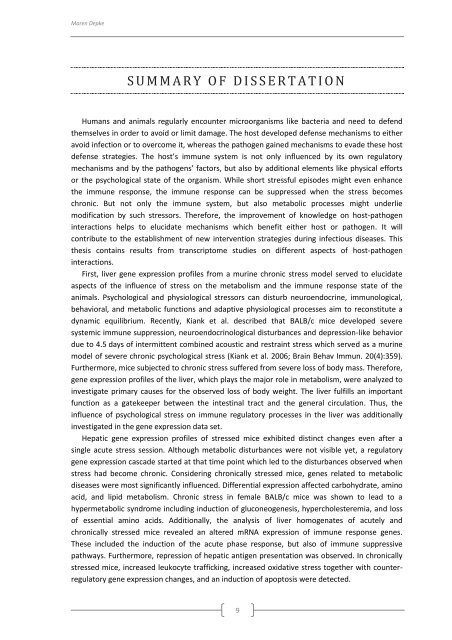genomewide characterization of host-pathogen interactions by ...
genomewide characterization of host-pathogen interactions by ...
genomewide characterization of host-pathogen interactions by ...
Create successful ePaper yourself
Turn your PDF publications into a flip-book with our unique Google optimized e-Paper software.
Maren Depke<br />
S U M M A R Y O F D I S S E R T A T I O N<br />
Humans and animals regularly encounter microorganisms like bacteria and need to defend<br />
themselves in order to avoid or limit damage. The <strong>host</strong> developed defense mechanisms to either<br />
avoid infection or to overcome it, whereas the <strong>pathogen</strong> gained mechanisms to evade these <strong>host</strong><br />
defense strategies. The <strong>host</strong>’s immune system is not only influenced <strong>by</strong> its own regulatory<br />
mechanisms and <strong>by</strong> the <strong>pathogen</strong>s’ factors, but also <strong>by</strong> additional elements like physical efforts<br />
or the psychological state <strong>of</strong> the organism. While short stressful episodes might even enhance<br />
the immune response, the immune response can be suppressed when the stress becomes<br />
chronic. But not only the immune system, but also metabolic processes might underlie<br />
modification <strong>by</strong> such stressors. Therefore, the improvement <strong>of</strong> knowledge on <strong>host</strong>-<strong>pathogen</strong><br />
<strong>interactions</strong> helps to elucidate mechanisms which benefit either <strong>host</strong> or <strong>pathogen</strong>. It will<br />
contribute to the establishment <strong>of</strong> new intervention strategies during infectious diseases. This<br />
thesis contains results from transcriptome studies on different aspects <strong>of</strong> <strong>host</strong>-<strong>pathogen</strong><br />
<strong>interactions</strong>.<br />
First, liver gene expression pr<strong>of</strong>iles from a murine chronic stress model served to elucidate<br />
aspects <strong>of</strong> the influence <strong>of</strong> stress on the metabolism and the immune response state <strong>of</strong> the<br />
animals. Psychological and physiological stressors can disturb neuroendocrine, immunological,<br />
behavioral, and metabolic functions and adaptive physiological processes aim to reconstitute a<br />
dynamic equilibrium. Recently, Kiank et al. described that BALB/c mice developed severe<br />
systemic immune suppression, neuroendocrinological disturbances and depression-like behavior<br />
due to 4.5 days <strong>of</strong> intermittent combined acoustic and restraint stress which served as a murine<br />
model <strong>of</strong> severe chronic psychological stress (Kiank et al. 2006; Brain Behav Immun. 20(4):359).<br />
Furthermore, mice subjected to chronic stress suffered from severe loss <strong>of</strong> body mass. Therefore,<br />
gene expression pr<strong>of</strong>iles <strong>of</strong> the liver, which plays the major role in metabolism, were analyzed to<br />
investigate primary causes for the observed loss <strong>of</strong> body weight. The liver fulfills an important<br />
function as a gatekeeper between the intestinal tract and the general circulation. Thus, the<br />
influence <strong>of</strong> psychological stress on immune regulatory processes in the liver was additionally<br />
investigated in the gene expression data set.<br />
Hepatic gene expression pr<strong>of</strong>iles <strong>of</strong> stressed mice exhibited distinct changes even after a<br />
single acute stress session. Although metabolic disturbances were not visible yet, a regulatory<br />
gene expression cascade started at that time point which led to the disturbances observed when<br />
stress had become chronic. Considering chronically stressed mice, genes related to metabolic<br />
diseases were most significantly influenced. Differential expression affected carbohydrate, amino<br />
acid, and lipid metabolism. Chronic stress in female BALB/c mice was shown to lead to a<br />
hypermetabolic syndrome including induction <strong>of</strong> gluconeogenesis, hypercholesteremia, and loss<br />
<strong>of</strong> essential amino acids. Additionally, the analysis <strong>of</strong> liver homogenates <strong>of</strong> acutely and<br />
chronically stressed mice revealed an altered mRNA expression <strong>of</strong> immune response genes.<br />
These included the induction <strong>of</strong> the acute phase response, but also <strong>of</strong> immune suppressive<br />
pathways. Furthermore, repression <strong>of</strong> hepatic antigen presentation was observed. In chronically<br />
stressed mice, increased leukocyte trafficking, increased oxidative stress together with counterregulatory<br />
gene expression changes, and an induction <strong>of</strong> apoptosis were detected.<br />
9

















